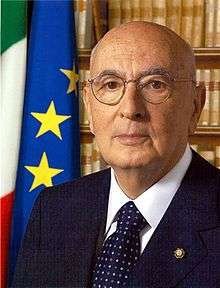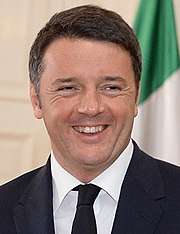Centre-left in Italy
The Centre-left appears in Italy for the first time in 1850 when the Historical Right leader Camillo Benso, Count of Cavour and the Historical Left one, Urbano Rattazzi, joined a coalition known as Connubio. The other main political bloc is the Centre-right. Important leaders of the Italian centre-left were Aldo Moro, Amintore Fanfani, Enrico Berlinguer, Romano Prodi, Matteo Renzi, Giorgio Napolitano, Massimo D'Alema, Giuliano Amato, Walter Veltroni, Enrico Letta, Francesco Rutelli and Pier Luigi Bersani.
History
Organic Centre-left

In 1962 the Christian Democracy (DC) leader Amintore Fanfani formed a cabinet with members of the Italian Social Democratic Party (PSDI) and the Italian Republican Party (PRI); it is considered the beginning of the Organic Centre-left.[1]
On 4 December 1963, Aldo Moro formed the first government with the support of the Italian Socialist Party (PSI). Prominent socialist politicians, such as Pietro Nenni and Antonio Giolitti, were appointed ministers.
After few years the Christian Democratic leader Mariano Rumor, proposed a new government coalition composed of centre-left parties. The Rumor cabinets approved the divorce law, a new Workers' Statute, the creation of the Antimafia Commission and a reform to give more powers and autonomy to the Regions. The coalition still judged the Italian Communist Party and the Italian Social Movement as too extreme for participation in government. Internationally, the coalition relied on a strong pro-Europeanism and atlanticism from a pro-Arab policy, (Craxi and Andreotti). This fact caused many frictions between the Liberals and the Socialists, and was one of the causes of disintegration of the coalition.
Historic Compromise
The Historic Compromise was an Italian historical political alliance and accommodation between Christian Democrats and Communists in the 1970s.
In 1973, the Italian Communist Party's General Secretary Enrico Berlinguer launched in Rinascita (a communist magazine) a proposal for a "democratic alliance" with the Christian Democracy, embraced by Aldo Moro. The call for this alliance was inspired by the overthrow of the Allende Government in Chile. For Berlinguer, the events in Chile proved that the Marxist left could not aspire to govern in democratic countries without establishing alliances with more moderate forces. After the 1973 Chilean coup, there was cooperation between the PCI and DC that became a political alliance in 1976. Then Berlinguer's PCI attempted to distance itself from the USSR, with the launching of "Eurocommunism" along with the Spanish Communist Party and the French Communist Party.
However, the Compromise was unpopular among the other moderate leftist groups like the PRI and PSI, led respectively by Ugo La Malfa and Bettino Craxi. Also the centristi Christian Democrat Giulio Andreotti had doubts about the accommodation.[2] At the DC XIV Congress of 1980, the DC's moderate wing ("Democratic Initiative", "Dorothean" and "New Force") won with an anti-communist program, obtaining the 57.7% of the vote, while the DC's conservative wing led by Benigno Zaccagnini and Giulio Andreotti's faction "Spring", ironically, obtained 42.3% with a pro-Compromise programme. The new DC Secretary became Flaminio Piccoli, a Dorothean, and the Compromise was discontinued. On November 1980 Berlinguer announced the end of the Historic Compromise.
The Olive Tree
The Olive Tree was a denomination used for several successive centre-left political and electoral alliances of Italian political parties from 1995 to 2007. The historical leader and ideologue of these coalitions was Romano Prodi, Professor of Economics and former leftist Christian Democrat, who invented the name and the symbol of The Olive Tree with Arturo Parisi in 1995.[3]
On 21 April 1996, The Olive Tree won 1996 general election in alliance with the Communist Refoundation Party (PRC), making Romano Prodi the Prime Minister of Italy. It was the first time since 1946 that the Communists, now gathered in the Democratic Party of the Left, took part in the government of the country and one of their leaders, Walter Veltroni, who ran in ticket with Prodi in a long electoral campaign, was Deputy Prime Minister.
On 9 October 1998, the Prodi I Cabinet fell when PRC left the alliance. Since 21 October 1998 The Olive Tree was the core of the governments led by Massimo D'Alema and by Giuliano Amato. When D'Alema became Prime Minister, it was the first time ever in Italy and in Europe that an heir of the communist tradition came to lead a government. On 13 May 2001, led by Francesco Rutelli, who ran in ticket with Piero Fassino, the coalition lost the general elections against Silvio Berlusconi and his House of Freedoms centre-right coalition.
The Union

The Union was the direct heir of The Olive Tree coalition. However, The Union was an heterogenous alliance that h also included parties of the radical left, which were not part of The Olive Tree.
Romano Prodi won the April 2006 general election by a very narrow margin due to Calderoli new electoral law, although Silvio Berlusconi first refused to acknowledge defeat. Prodi's coalition proved to be extremely frail, as the two-vote margin in the Senate allowed almost any party in the coalition to veto legislation and political views inside the coalition spanned from far-left Communist parties to Christian Democrats.
The centre-left majority coalition, on 7 May 2006, officially endorsed Giorgio Napolitano as its candidate in the presidential election that began on 8 May. The Vatican endorsed him as President through its official newspaper, L'Osservatore Romano, just after The Union named him as its candidate, as did Marco Follini, former secretary of the Union of Christian and Centre Democrats, a member party of the House of Freedoms. Napolitano was elected on 10 May, in the fourth round of voting — the first of those requiring only an absolute majority, unlike the first three which required two-thirds of the votes — with 543 votes (out of a possible 1009). At the age of 80, he became the first former Communist to become President of Italy
Less than a year after he had won the elections, on 21 February 2007, Prodi tendered his resignation to President Napolitano after the government was defeated in the Senate by 2 ballots in a vote on foreign policy. On 24 February, President Napolitano invited him to return to office and face a vote of confidence.
Major causes of friction inside the coalition were, the 2006 pardon Act (criticised by the right and by the IDV party), a draft bill to establish civil unions (vetoed by Christian Democrats), Italy's continued involvement in Afghanistan (strongly opposed by left-wing parties), and finally the much publicized house-arrest of Clemente Mastella's wife (then a prominent politician at the regional level) over a corruption scandal. Mastella's party, UDEUR, held just enough seats in the Senate that his eventual decision to withdraw its support for the government meant the end of the legislature on February 6, 2008. Mastella, who also resigned from his office as Minister of Justice, cited the lack of personal support from his coalition partners' as one the reasons behind his decision,[4] together with a proposed reform of the electoral system which would have made it difficult for small parties like his own to gain seats in the Italian Parliament.
Democratic Party

The Democratic Party was founded on 14 October 2007 as a merger of various centre-left parties which had been part of The Union in the 2006 general election. At foundation the majority of the PD was formed by the Democrats of the Left (heirs of the Italian Communist Party) and the largely Catholic-inspired Democracy is Freedom – The Daisy.[5] Within the party, an important role is thus played by Christian leftists, who are direct heirs of the former Christian Democracy's left.[6][7][8]
After the resignation of Silvio Berlusconi as Prime Minister in November 2011, the PD gave external support to Mario Monti's technocratic government.[9][10] Since April 2013 Enrico Letta, a Democrat, was Prime Minister, at the head of a government sustained by a grand coalition including The People of Freedom (later replaced by the New Centre-Right), Civic Choice (later divided in two, after the split of the Populars for Italy) and the Union of the Centre. Following his election as party leader, in February 2014 Matteo Renzi called for "a new phase" and, consequently, the party's national board voted to ask Letta to resign.[11][12] Subsequently, Renzi was sworn in as Prime Minister at the head of the same coalition.[13]
Following the 2013 general election and the 2014 European Parliament election, the PD was the largest party in the Chamber of Deputies, the Senate and the European Parliament, respectively. As of 2015, other than the national government, Democrats head fifteen regional governments out of twenty and function as coalition partner in Trentino-Alto Adige/Südtirol.
Electoral results
Italian Parliament
| Chamber of Deputies | ||||||
| Election year | # of overall votes |
% of overall vote |
# of overall seats won |
+/– | Leader | |
|---|---|---|---|---|---|---|
| 1996 | 15,758,981 (#1) | 42.2 | 322 / 630 |
|||
| 2001 | 16,209,944 (#2) | 43.5 | 247 / 630 |
|||
| 2006 | 19,036,986 (#1) | 49.8 | 348 / 630 |
|||
| 2008 | 13,689,303 (#2) | 37.5 | 239 / 630 |
|||
| 2013 | 10,047,603 (#1) | 29.5 | 345 / 630 |
|||
| Senate of the Republic | |||||
| Election year | # of overall votes |
% of overall vote |
# of overall seats won |
+/– | Leader |
|---|---|---|---|---|---|
| 1996 | 13,444,977 (#1) | 41.2 | 169 / 315 |
||
| 2001 | 13,282,495 (#2) | 39.2 | 128 / 315 |
||
| 2006 | 17,118,364 (#2) | 49.2 | 158 / 315 |
||
| 2008 | 12,457,182 (#2) | 38.7 | 130 / 315 |
||
| 2013 | 9,686,683 (#1) | 31.6 | 127 / 315 |
||
References
- ↑ Il centro-sinistra e i governi Moro
- ↑ Fallaci, Oriana (1974). Intervista con la storia. Rizzoli.
- ↑ L'Ulivo
- ↑ BBC, 16 January 2008 Italian justice minister resigns(in English)
- ↑ Hans Slomp (2011). Europe, a Political Profile: An American Companion to European Politics. ABC-CLIO. p. 406. ISBN 978-0-313-39181-1. Retrieved 13 August 2013.
- ↑ Vespa, Bruno (2010). Il Cuore e la Spada: Storia politica e romantica dell'Italia unita, 1861-2011. Mondadori. p. 650.
- ↑ Augusto, Giuliano (8 December 2013), "De profundis per il Pd", Rinascita, archived from the original on 1 March 2014
- ↑ Gioli, Sergio (19 November 2013), "Ultimo treno a sinistra", Quotidiano.net
- ↑ "Via libera definitivo a Monti "Clima nuovo, ce la faremo"". Corriere della Sera. 19 November 2011. Retrieved 6 June 2013.
- ↑ "Camera, fiducia ampia Il Pdl: esecutivo di tregua, l' Ici si può riesaminare". Corriere Della Sera. 19 November 2011. Retrieved 6 June 2013.
- ↑ "Italian PM Enrico Letta to resign", The Guardian
- ↑ "Renzi liquida Letta: "Via dalla palude" Venerdì il premier al Quirinale per le dimissioni", Corriere.it
- ↑ Rubino, Monica, "Il governo Renzi ha giurato al Colle, è in carica. Gelo con Letta alla consegna della campanella", Repubblica.it
.jpg)